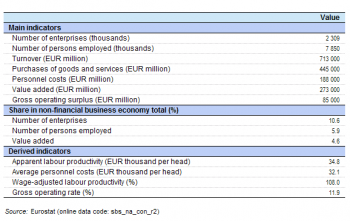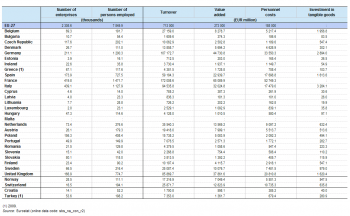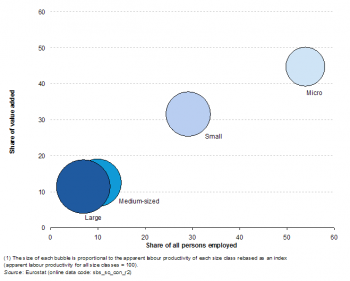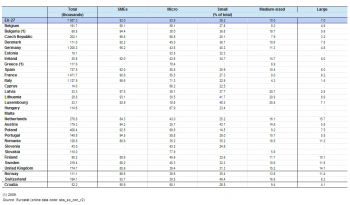- Data from April 2013. Most recent data: Further Eurostat information, Main tables and Database.
This Statistics Explained article is outdated and has been archived - for recent articles on structural business statistics see here.
This article presents an overview of statistics for specialised construction activities in the European Union (EU), as covered by NACE Rev. 2 Division 43. As well as work on new structures, renovation, repair and maintenance markets are also important for enterprises in this sector, for example, for enterprises involved with installation, completion and finishing activities.


(% share of sectoral total) - Source: Eurostat (sbs_na_con_r2)







(% share of sectoral total) - Source: Eurostat (sbs_sc_con_r2)


Main statistical findings
Structural profile
In terms of a simple count of the number of enterprises, the specialised construction activities sector (Division 43) was by far the largest of the three NACE divisions within construction (Section F) in the EU-27 in 2010. In total there were 2.3 million enterprises active in this sector, equivalent to 70.1 % of all construction enterprises and more than 1 in 10 (10.6 %) of all enterprises in the non-financial business economy (Sections B to J and L to N and Division 95). These enterprises employed 7.85 million persons, equivalent to 5.9 % of the non-financial business economy workforce and 58.5 % of the construction workforce. They generated EUR 273 billion of value added which was approximately 4.6 % of the non-financial business economy total and 55.0 % of the construction total. These figures suggest that the specialised construction activities sector is composed of a very large number of relatively small enterprises.
The apparent labour productivity of the EU-27’s specialised construction activities sector in 2010 was EUR 34.8 thousand per person employed. This was the lowest apparent labour productivity among the three construction NACE divisions and was around one fifth lower than the non-financial business economy average (EUR 44.8 thousand per person employed). Despite this low level of apparent labour productivity, average personnel costs within the EU-27’s specialised construction activities sector were, at EUR 32.1 thousand per employee, above the non-financial business economy average (EUR 30.9 thousand per employee) and the construction average (EUR 31.4 thousand per employee). Low apparent labour productivity and high average personnel costs resulted in a low wage-adjusted labour productivity ratio — an indicator that is derived by combining the two previous measures. The wage-adjusted labour productivity ratio for the EU-27’s specialised construction activities sector in 2010 was just 108.0 %, the third lowest among all NACE divisions within the non-financial business economy.
Often a low wage-adjusted labour productivity ratio is accompanied by a low gross operating rate (the relation between the gross operating surplus and turnover), but this was not the case for the EU-27’s specialised construction activities sector, where the gross operating rate was 11.9 %, above the non-financial business economy average (10.1 %) and the construction average (10.7 %). The relatively high gross operating surplus for the specialised construction activities sector occurs because of a combination of elements: there are many working proprietors and/or unpaid family workers in this sector, and so the share of paid employees in the total number of persons employed is low (74.5 % compared with a construction average of 85.7 %); this leads to a relatively low level of total (rather than average) personnel costs, which in turn results in a relatively high gross operating surplus. Nevertheless, it should be borne in mind that the large number of working proprietors and unpaid family workers are (generally) recompensed from the gross operating surplus.
Sectoral analysis
Within the EU-27, the two largest specialised construction subsectors were electrical, plumbing and other construction installation activities (Group 43.2, hereafter referred to as the construction installation subsector) and the building completion and finishing subsector (Group 43.3). Together they contributed around three quarters of sectoral employment in the EU-27 in 2010 and a slightly smaller share of value added — see Figure 1. The third largest subsector was other specialised construction activities (Group 43.9) which contributed just under one fifth of sectoral employment and value added, just under three times the size of the smallest subsector, namely the demolition and site preparation subsector (Group 43.1).
The apparent labour productivity of the four subsectors varied from EUR 30.3 thousand of value added per person employed for the EU-27’s building completion and finishing subsector to EUR 38.0 thousand per person employed for demolition and site preparation. The range in average personnel costs was much narrower, from a low of EUR 30.6 thousand per employee for building completion and finishing rising to EUR 33.3 thousand per employee for other specialised construction activities.
The low wage-adjusted labour productivity ratio for the EU-27’s specialised construction activities sector as a whole was pulled downwards by the building completion and finishing subsector, as the ratio for this activity was just 99.1 %; this was not only the lowest wage-adjusted labour productivity ratio among the EU-27’s construction NACE groups in 2010, but also the seventh lowest among all NACE groups within the non-financial business economy. The wage-adjusted labour productivity ratio was also below the construction average of 117.7 % for the three other subsectors, peaking at 116.0 % for demolition and site preparation.
In contrast to the wage-adjusted labour productivity ratio, the gross operating rate for these four subsectors within the EU-27 were all relatively high, in each case the rate was above the non-financial business economy average for 2010 (10.1 %). For the other specialised construction activities and construction installation subsectors the gross operating rate was close to the construction average (10.7 %), while for the two remaining subsectors it was higher, peaking at 14.7 % for building completion and finishing.
Country analysis
In value added terms, France had the largest specialised construction activities sector among the EU Member States in 2010 and recorded the highest level of value added among the Member States across each of the four subsectors. France’s share of EU-27 value added averaged 23.8 % for the whole of the specialised construction activities sector, and rose as high as 34.5 % for the other specialised construction activities subsector. France’s share of EU-27 value added in this sector was its third highest share of EU-27 value added in 2010 among all of the non-financial business economy NACE divisions.
The relative importance of specialised construction activities was also highest in France, as this sector contributed 7.5 % to non-financial business economy value added in 2010, ahead of Luxembourg (6.1 %). The EU Member States that were least specialised in the specialised construction activities sector in 2010 were Ireland, Latvia, Romania, Bulgaria, Hungary, and Lithuania, where specialised construction activities contributed less than 2.5 % of non-financial business economy value added.
The very low wage-adjusted labour productivity ratio recorded for the EU-27’s specialised construction activities sector in 2010 was a reflection of particularly low ratios in several EU Member States: two of the largest Member States, Italy and Spain, recorded wage-adjusted labour productivity ratios below 100 %, as did Greece (2009 data). All Member States (among those with data available) recorded a wage-adjusted labour productivity ratio for the specialised construction activities sector that was below their national average for the whole of the non-financial business economy.
Despite recording the lowest wage-adjusted labour productivity ratio among the EU Member States, Greece registered a gross operating rate of 23.2 % for specialised construction activities in 2009; in 2010 only Slovakia recorded a higher gross operating rate (26.3 %); Ireland (21.1 %), the United Kingdom (19.9 %) and Poland (19.0 %) also recorded relatively high gross operating rates.
Size class analysis
The enterprise size structure of the EU-27’s specialised construction activities sector is one of the most dominated by small and medium-sized enterprises (SMEs, employing fewer than 250 persons) within the non-financial business economy. SMEs employed 93.0 % of the specialised construction activities workforce and contributed 88.6 % of value added; for employment this was the third highest share in 2010 among the non-financial business economy NACE divisions, while for value added it was the fourth highest. For comparison, the non-financial business economy average for SMEs was two thirds (67.5 %) of employment and under three fifths (57.5 %) of value added. Despite their relatively low contribution to the EU-27’s specialised construction activities sector, large enterprises recorded the highest apparent labour productivity, EUR 55.3 thousand per person employed, close to double the level (EUR 28.8 thousand per person employed) for micro enterprises (employing fewer than 10 persons).
Only in the Netherlands, the United Kingdom, Sweden, Romania and Finland did large enterprises employ more than one tenth of the workforce in specialised construction activities in 2010, as they also did in Norway. The value added contribution of large enterprises reached 20.6 % in the Netherlands and exceeded one tenth in 10 other EU Member States. The lowest value added contribution of micro enterprises was 13.3 % in Lithuania, while such enterprises generated at least one fifth of the value added generated in all of the remaining Member States for which data are available. Micro enterprises contributed more than half of the value added generated in specialised construction activities in nine of the Member States, reaching a 60.2 % share in Greece (2009 data) and 64.2 % in Slovakia.
Data sources and availability
The analysis presented in this article is based on the main dataset for structural business statistics (SBS) and size class data, all of which are published annually.
The main series provides information for each EU Member State as well as a number of non-member countries at a detailed level according to the activity classification NACE. Data are available for a wide range of variables.
In structural business statistics, size classes are generally defined by the number of persons employed. A limited set of the standard structural business statistics variables (for example, the number of enterprises, turnover, persons employed and value added) are analysed by size class, mostly down to the three-digit (group) level of NACE. The main size classes used in this article for presenting the results are:
- small and medium-sized enterprises (SMEs): with 1 to 249 persons employed, further divided into;
- micro enterprises: with less than 10 persons employed;
- small enterprises: with 10 to 49 persons employed;
- medium-sized enterprises: with 50 to 249 persons employed;
- large enterprises: with 250 or more persons employed.
Context
This article presents an overview of statistics for the specialised construction activities sector in the EU, as covered by NACE Rev. 2 Division 43. This division includes specialised construction activities, also referred to as special trades, in other words, the construction of parts of buildings and civil engineering works or preparation therefore. These activities are usually specialised in one aspect common to different structures, requiring specialised skills. Specialised construction activities are mostly carried out under subcontract, but especially in repair construction it is done directly for the owner of the property. Building finishing and building completion activities are usually performed at the site of the construction, although parts of the job may be carried out in a special (work)shop.
Demolition and site preparation includes activities of preparing a site for subsequent construction activities, including the demolition/wrecking and removal of previously existing structures, earth moving, excavation, landfill, levelling and grading of construction sites, trench digging, rock removal, blasting, and so on. Also included is building site drainage, drainage of agricultural or forestry land, site preparation for mining and test drilling and boring.
Construction installation activities include electrical, plumbing, heating and air-conditioning installation, as well as the installation of elevators, escalators, automated and revolving doors, lightning conductors, vacuum cleaning systems as well as thermal, sound or vibration insulation.
Building completion and finishing includes: plastering; joinery installation such as doors, windows, frames, staircases, fitted kitchens, built-in cupboards, shop fittings, ceilings and movable partitions; fitting or laying of floor and wall coverings of wood, carpet, linoleum, stone, tiles or wallpaper; interior and exterior painting and glazing; cleaning of new buildings after construction and other building completion and finishing work.
Other specialised construction activities include roofing activities such as the erection of roofs and roof covering as well as specialisation in one aspect common to different kinds of structures, requiring specialised skill or equipment: the construction of foundations; damp proofing and water proofing works; de-humidification of buildings; shaft sinking; the erection of non-self-manufactured steel elements; bricklaying and stone setting; scaffolding; the erection of chimneys and industrial ovens; the construction of outdoor swimming pools; renting (with operator) of cranes and other building equipment which cannot be allocated to a specific construction type, with operator.
This NACE division is composed of four groups:
- demolition and site preparation (Group 43.1);
- electrical, plumbing and other construction installation activities (Group 43.2);
- building completion and finishing (Group 43.3);
- other specialised construction activities (Group 43.9).
The information presented in this article does not cover the decontamination of soil (which forms part of remediation activities and other waste management services, Division 39), the drilling of production oil or gas wells (included within the extraction of crude petroleum and natural gas, Division 06), or oil and gas field exploration, geophysical, geological and seismic surveying (included in architectural and engineering activities; technical testing and analysis, Division 71). Furthermore, the renting of construction machinery and equipment without operator (classified within rental and leasing activities, Division 77) is also excluded.
See also
- Construction
- Other analyses of the business economy by NACE Rev. 2 sector
- Structural business statistics introduced
Further Eurostat information
Publications
- European business - facts and figures (online publication)
- Key figures on European Business – with a special feature section on SMEs – 2011 edition
Main tables
Database
- SBS - industry and construction (sbs_ind_co)
- Annual detailed enterprise statistics - industry and construction (sbs_na_ind)
- Annual detailed enterprise statistics for construction (NACE Rev. 2 F) (sbs_na_con_r2)
- SMEs - Annual enterprise statistics by size class - industry and construction (sbs_sc_ind)
- Construction by employment size class (NACE Rev. 2 F) (sbs_sc_con_r2)
- Annual detailed enterprise statistics - industry and construction (sbs_na_ind)
- SBS - regional data - all activities (sbs_r)
- SBS data by NUTS 2 regions and NACE Rev. 2 (from 2008 onwards) (sbs_r_nuts06_r2)
Dedicated section
Source data for tables and figures (MS Excel)
Other information
- Decision 1578/2007/EC of 11 December 2007 on the Community Statistical Programme 2008 to 2012
- Regulation 295/2008 of 11 March 2008 concerning structural business statistics
External links
- Joint research centre, see:
